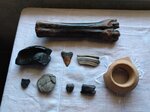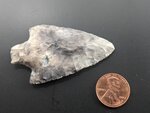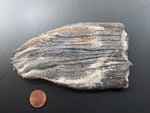


Dave Tyler wandered down the Solana Road public beach access ramp to water’s edge to do what he did on a regular basis: gather the sharks’ teeth that had washed up on the shore. This day turned out to be different. Something out of the ordinary caught his eye. He bent over to see what it was and lo and behold! It was a spear point some Indian from ancient times had lost in the waves while spearfishing for his supper in the days long before European settlers arrived to establish their first villages here.
“I almost missed it,” he says. “I walked past it without picking it up, then something told me to double back to give it a closer look. Through the years, I have found over 12,000 sharks’ teeth. I also had found a deer antler, horse teeth and even a tooth from a prehistoric camel — but until that day, never anything left behind by the Indians!”
Current Ponte Vedrans may be baffled to learn that at other periods in the Earth's geologic history — when the Ice Age had captured huge quantities of the planet’s water and confined them to the latitudes stretching from the North Pole all the way down to the top quarter of the United States — the Florida shoreline was not where it is now. It was many miles east of its current location, providing marshlands and savannas where long-extinct animals frolicked and foraged.
This period was known as the Pleistocene Epoch, with this area being a cageless zoo housing animals like bison, horses, camels, woolly mammoths, mastodons, saber-tooth tigers, giant sloths and other creatures that current residents would be shocked to know inhabited the land.
Many of these animals died where they lived, and now each receding tide unlocks a treasure chest containing their mortal remains for beachcombers to gather up and display on their mantels and bookshelves.
Some places in Florida where Spanish galleons sank even have been known to litter the beaches with gold and silver coins! Sadly, no Ponte Vedrans have reported finds of that nature. But still, what has been found has been significant, and been a source of joy for the lucky person who retrieved it. The diligent and the vigilant have been rewarded countless times over for their scavenging efforts.
Patricia Winters is another avid hunter and gatherer, and was fortunate enough to discover there were illustrated pamphlets available to help her identify her unusual finds. By matching the pictures with the objects she recovered, she has been able to ascertain exactly what they were. Her bookcases are now serving as a home museum for all her found acquisitions.
“I have a jarful of bone fragments, but it's difficult to identify the creature that they came from,” she points out. “Some, undoubtedly, came from prehistoric sharks. One that I was able to identify is a large leg bone (metatarsal) from a bison. When I spotted it in the waves, I thought it was the arm of a piece of furniture. Upon closer inspection, I realized it was something unique and fortunately decided to keep it. I like to patrol the beaches, especially during the winter when it’s more isolated and peaceful. Having the access to the beach that we do is really a privilege. Every beach walk is a treasure hunt. The ocean contains many secrets and has so many wonderful things to offer us if we just keep our eyes open.”
Have you found something unique or unusual during one of your beach excursions? Email a picture of it with your name and contact information to mcmulhern1@yahoo.com so we can consider featuring it in a future edition of The Recorder.